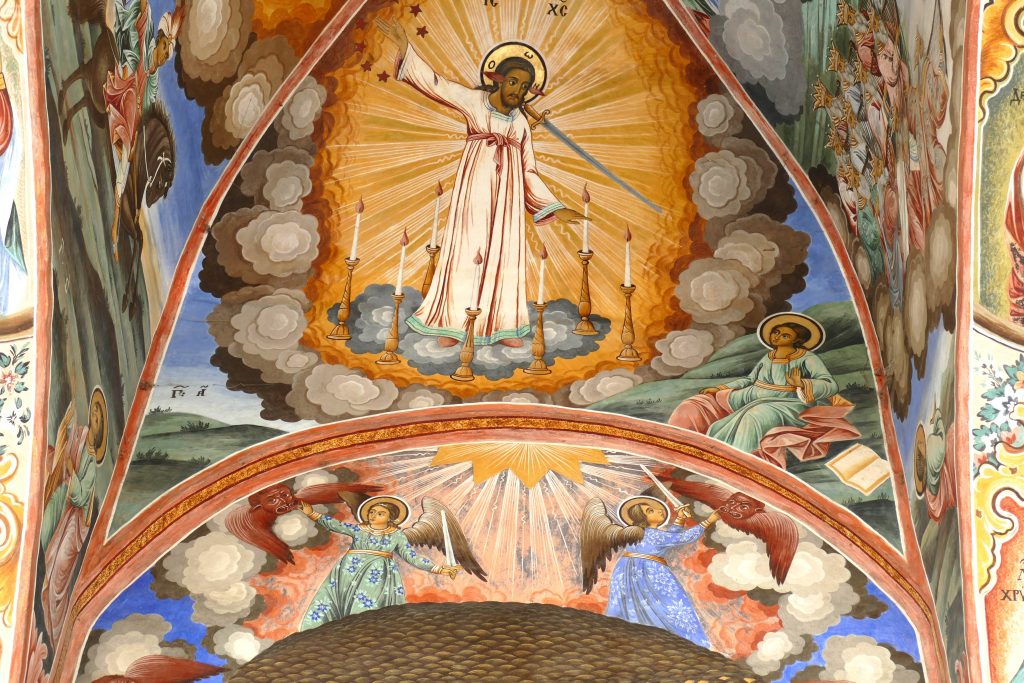We’ll visit the Rila monastery on our spring 2024 small group tour
The 10th century Rila Monastery is 121 km (75 miles) south of Sofia at the end of a winding road. Mountains rise all around it; below it the Rilska River races over a stony bed. In the 9th century, twenty-year old Ivan Rilski (John of Rila) fled to this peaceful place seeking escape from the sinfulness of the world. Finding a cave in the woods above this present monastery site, he took up the hermit life. Here he fed the animals and the birds and prayed in the stillness to God. In time, like-minded men joined him, and they built the first monastery. In the past, pilgrims were not deemed sinless enough to enter the monastery.
The first monastery was established in the 14th century, but it wasn’t until the middle of the 19th century—following a fire in 1833—that transformed into the magnificent structure of today. Rila Monastery was a significant hub for the Bulgarian language and culture when Bulgaria was still a part of the Ottoman Empire. Today Rila Monastery is one of Europe’s largest monasteries, located in some of Bulgaria’s most beautiful terrain.
The monastery was listed as a national historical monument in 1976 and seven years later by UNESCO because it is one of the most impressive examples of Bulgarian National Revival. The inscription to the World Heritage List says Rila Monastery is “a characteristic example of the Bulgarian Renaissance (18th–19th centuries), the monument symbolizes the awareness of a Slavic cultural identity following centuries of occupation.”
It’s a 1-2 hr drive over 120 km, so it’s a popular day-trip from Sophia. There’s a daily bus, but it takes 3+ hours each way. Despite the huge popularity of the site, this is still a working monastery, with around 60 monks living there.
The monastery complex features a distinctive architectural style, characterized by its Hrelyo’s Tower, a six-story residential and defensive tower, and the main church which is adorned with impressive frescoes both inside and out.

The interior and exterior of the monastery’s main church, known as the Nativity of the Virgin Church, display exquisite frescoes painted by some of the most renowned Bulgarian artists of the time. The iconostasis, a wooden screen covered with icons, is also a remarkable piece of religious art.
The monastery has been home to a community of monks for centuries, who continue to follow a monastic way of life. They are involved in various activities including prayer, worship, and maintaining the monastery grounds. While you can’t photograph the ornate interior, the exterior frescoes will captivate both pilgrims and photographers.
The frescoes highlight religious themes from the Eastern Orthodox Christian tradition. They portray scenes from the Bible, the lives of saints, and various theological and moral lessons, includimng many scenes of angels, demons and fantastical creatures of hell.
Their Byzantine artistic style uses of vibrant colors, expressive facial features, and a certain degree of stylization. The iconography in the frescoes is rich and varied. It includes depictions of Christ, the Virgin Mary, angels, saints, and biblical events. These images are arranged in a coherent narrative that tells the story of Christianity.
Over the centuries, the frescoes have undergone various cycles of preservation and restoration efforts to ensure their longevity. This is due to exposure to the elements and natural wear and tear.The frescoes are seamlessly integrated into the architectural design of the monastery. They cover large portions of the exterior walls, creating a harmonious and visually striking ensemble.



Throughout its long history, the monastery has faced various challenges, including fires and attacks, but it has managed to survive and even flourish. It stands as a symbol of Bulgarian resilience and faith.
Today it’s a major tourist attraction in Bulgaria and receives visitors from all over the world but especially those of the Orthodox churches. Many people also come on pilgrimage due to its religious significance.
The monastery is situated in a stunning natural setting amidst the Rila Mountains. The surrounding scenery is picturesque and offers opportunities for hiking and outdoor activities. If you’re planning to visit the Rila Monastery and are looking for accommodation options nearby, there are several options available. Keep in mind that availability may vary depending on the time of year and local events.
The monastery has a few guesthouses where you can stay. This allows you to be right on the grounds, which can be a unique experience. There are several guesthouses and B&Bs in the vicinity of the Rila Monastery. These can offer a cozy and more intimate lodging experience. While there may not be large hotel chains right next to the monastery, you can find smaller hotels and resorts in the nearby towns and villages. They often offer a range of amenities and services. Some local families operate small inns or guesthouses that offer a comfortable and welcoming stay. These can provide a more personalized experience. Given the picturesque location of the Rila Monastery in the mountains, there might be lodges or chalets available for rent. These can offer a unique and scenic lodging experience.
Order prints, greeting cards, clothing, and other merchandise
Order prints, greeting cards, clothing, and other merchandise
Our latest small group tours
Turkey Travel blog